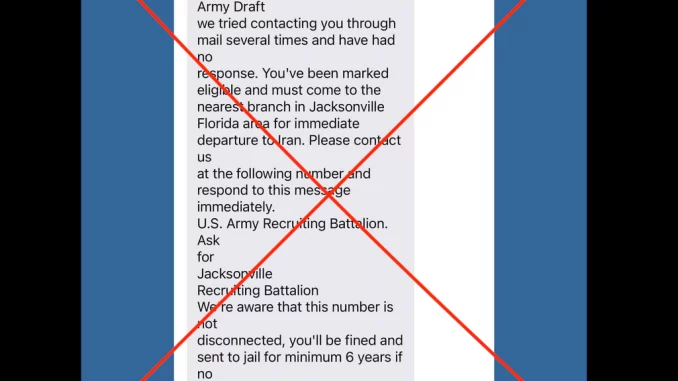
Army Recruiting Command warned Tuesday that scammers are sending fake texts about a supposed military draft, a repeat of similar frauds that popped up in 2020 amid a period of spiraling tensions with Iran.
“These messages are false and were not initiated by the U.S. Army Recruiting Command,” said USAREC officials in a press release. “The messages, which are similar to those circulated two years ago, have been sent to various members of the public over the past week.”
The new messages first surfaced last week after Russia’s invasion of Ukraine, which has raised fears of a broader European war in the unlikely event that fighting breaks out between Russian and NATO forces. No U.S. or NATO troops are in Ukraine.
RELATED
:quality(70)/cloudfront-us-east-1.images.arcpublishing.com/mco/BSEC3ORVIZAATALLA3WBMBU3KQ.jpg)
The release included an image seemingly first posted by Recruiter Times, a social media page dedicated to news and rumors in USAREC, of a purported scam text.
The false message, claiming to be the “United States Official Army Draft,” informs recipients that they’ve “been marked eligible” after attempts to reach them via mail.
Recipients of the fake notice are threatened with jail time if they don’t call the phone number associated with the text, which references Iran rather than Ukraine. Military Times was unable to find a match for the new message among draft scam screenshots from 2020, though, suggesting that the message may have been sent recently despite the error.
How the draft actually works
In the release, USAREC officials explained that the military draft isn’t even administered by the Army, and conscription hasn’t been in place for Americans since 1973. All members of the U.S. military are volunteers.
“The Selective Service System, a separate agency outside of the Department of Defense, is the organization that manages registration for the Selective Service,” the release explained.
All American men between the ages of 18 and 25 are required to register for Selective Service, which retains that information in order to quickly reestablish a draft if ever necessary. But doing so would take an act of Congress, the release explained, and there is virtually no political appetite for reactivating the draft absent an existential threat to America.
If it ever were put back into place, the draft would not immediately induct all eligible Americans. Instead, Selective Service would utilize a lottery system to randomly select men turning 20 in the lottery’s calendar year. Sometimes when manpower needs are dire, the lottery will expand the years of birth it selects from.
A televised lottery would use two lottery machines, one loaded with birth dates and a second loaded with sequence numbers 1 to 365, to assign the formal order in which that calendar year’s 20-year-olds would be called to military service. The first draft lottery on Dec. 1, 1969, for example, assigned sequence number 1 to men born on Sept. 14 between 1944 and 1950. That year’s draft ultimately inducted men through sequence number 195 to go fight in Vietnam.
Once that year’s 20-year-olds are assigned to a sequence number, the Defense Department will determine what its manpower needs are, and the Selective Service System will determine how many sequence numbers are needed to meet the manpower needs from that year’s draft pool. They’d then send draft notices beginning with men born on dates corresponding to the selected sequence numbers.
An unnamed Selective Service spokesperson described the system as “fair and equitable” in the USAREC release, adding that there would be an “Alternate Service Program for conscientious objectors” in the unlikely event that a draft ever again occurs.
Davis Winkie is a staff reporter covering the Army. He originally joined Military Times as a reporting intern in 2020. Before journalism, Davis worked as a military historian. He is also a human resources officer in the Army National Guard.



Be the first to comment